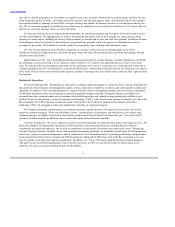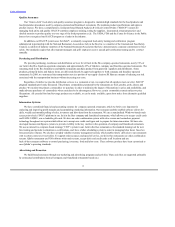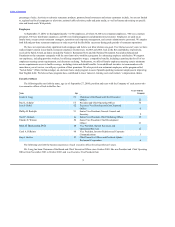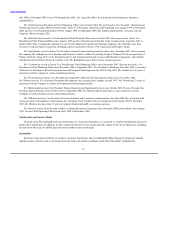Jack In The Box 2009 Annual Report Download - page 17
Download and view the complete annual report
Please find page 17 of the 2009 Jack In The Box annual report below. You can navigate through the pages in the report by either clicking on the pages listed below, or by using the keyword search tool below to find specific information within the annual report.
Table of Contents
not limited to the following: (i) our credit rating may be reduced; (ii) our ability to obtain additional financing in the future for
acquisitions, working capital, capital expenditures, and general corporate or other purposes could be impaired, or any such financing
may not be available on terms favorable to us; (iii) a substantial portion of our cash flows could be required for debt service and, as a
result, might not be available for our operations or other purposes; (iv) any substantial decrease in net operating cash flows or any
substantial increase in expenses could make it difficult for us to meet our debt service requirements or force us to modify our operations
or sell assets; (v) our ability to withstand competitive pressures may be decreased; and (vi) our level of indebtedness may make us more
vulnerable to economic downturns and reduce our flexibility in responding to changing business, regulatory and economic conditions.
Our ability to repay expected borrowings under our credit facility and to meet our other debt or contractual obligations (including
compliance with applicable financial covenants) will depend upon our future performance and our cash flows from operations, both of
which are subject to prevailing economic conditions and financial, business and other known and unknown risks and uncertainties,
certain of which are beyond our control.
Risks of Market Volatility. Many factors affect the trading price of our stock, including factors over which we have no control,
such as reports on the economy or the price of commodities, as well as negative or positive announcements by competitors, regardless of
whether the report relates directly to our business. In addition to investor expectations about our prospects, trading activity in our stock
can reflect the portfolio strategies and investment allocation changes of institutional holders and non-operating initiatives such as a share
repurchase program. Any failure to meet market expectations whether for sales growth rates, refranchising goals, earnings per share or
other metrics could cause our share price to drop.
Risks of Changes in Accounting Policies and Assumptions. Changes in accounting standards, policies or related interpretations
by auditors or regulatory entities may negatively impact our results. Many accounting standards require management to make subjective
assumptions and estimates, such as those required for stock compensation, tax matters, pension costs, litigation, insurance accruals and
asset impairment calculations. Changes in those underlying assumptions and estimates could significantly change our results.
Litigation. Litigation trends and potential class actions by consumers, shareholders and employees, and the costs and other effects
of legal claims by employees, franchisees, customers, vendors, stockholders and others, including settlement of those claims, could
negatively impact our results.
None.
The following table sets forth information regarding our Jack in the Box and Qdoba restaurant properties as of September 27, 2009:
Company-owned restaurant buildings:
On company-owned land 143 107 250
On leased land 392 248 640
Subtotal 535 355 890
Company-leased restaurant buildings on leased land 812 526 1,338
Franchise directly-owned or directly-leased restaurant buildings — 494 494
Total restaurant buildings 1,347 1,375 2,722
Our leases generally provide for fixed rental payments (with cost-of-living index adjustments) plus real estate taxes, insurance and
other expenses. In addition, less than 20% of the leases provide for contingent rental payments between 1% and 13% of the restaurant’s
gross sales once certain thresholds are met. We have generally been able to renew our restaurant leases as they expire at then-current market
rates. The remaining terms of ground leases range from approximately one year to 50 years, including optional renewal periods. The
remaining lease terms of our
16
























